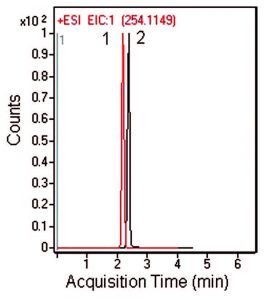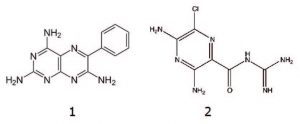LCMS Method for Spiked Urine Sample
This application note describes the separation of two important drugs for treatment of hypertension and congestive heart failure. Both compounds have numerous amine groups, which can contribute to Peak tailing in some instances. However, the Peak shapes observed here are both symmetrical and very efficient.
This is accomplished using the Diamond Hydride 2.o Column, which is well-suited to polar compounds such as these. A spiked Urine sample was used to demonstrate the applicability of the data to clinical studies.


Peaks:
1. Triamterene 254.1149 m/z [M + H]+
2. Amiloride 230.0552 m/z [M + H]+
Method Conditions
Column: Cogent Diamond Hydride 2.o™, 2.2μm, 120Å
Catalog No.: 70200-05P-2
Dimensions: 2.1 x 50mm
Mobile Phase:
—A: DI Water / 0.1% Formic Acid (v/v)
—B: Acetonitrile / 0.1% Formic Acid (v/v)
Gradient:
| Time (minutes) | %B |
| 0 | 80 |
| 3 | 30 |
| 5 | 30 |
| 6 | 80 |
Flow rate: 0.4 mL/minute
Detection: ESI – POS – Agilent 6210 MSD TOF Mass Spectrometer
Injection vol.: 1μL
Sample Preparation: Urine was spiked with Amiloride and Triamterene standard solutions and filtered with 0.45um Nylon Syringe Filter (MicroSolv Tech Corp.).
Note: Amiloride and Triamterene are Potassium-sparing Diuretics. Trade names include Dyrenium® and Midamor®. They are also sometimes combined with Hydrochlorothiazide, a Diuretic drug.
Attachment
No 323 Amiloride and Triamterene pdf 0.3 Mb Download File


